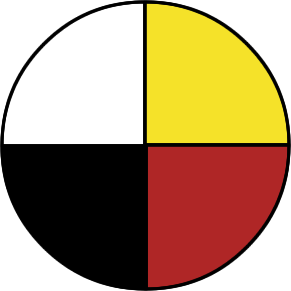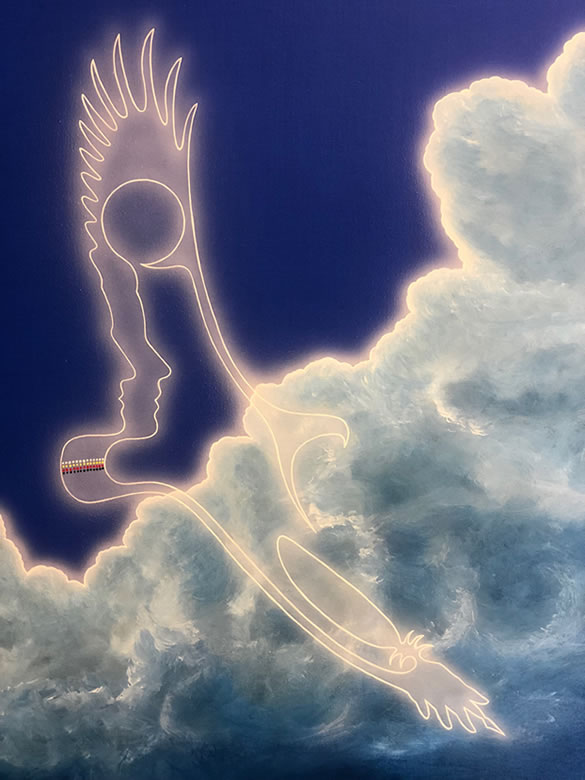Genoodmagejig
Genoodmagejig is an Anishinabe word which means “those who advocate.” It strongly implies believing in the cause that is advocated, as well as “supporting and guiding.”
The image opposite is intended to represent the concept of “Genoodmagejig.” It depicts an  eagle flying across the sky in front of a magnificent cloud. The colours used in the painting are those of the sky and water. Both sky and water play an important role for the Anishinabek People.
eagle flying across the sky in front of a magnificent cloud. The colours used in the painting are those of the sky and water. Both sky and water play an important role for the Anishinabek People.
The eagle is drawn from a single line. The continuous line represents unity and continuity. You will notice that there is more symbolism within the image of the eagle.  The circle in the one wing is symbolic of the infinite and completeness.
The circle in the one wing is symbolic of the infinite and completeness.
There are also  two faces on the same wing, a man and a woman, which represent the people. These two faces also represent one person guiding another. The necks of the people form the tail of the eagle. Inside the tail, you can see a necklace with beadwork in the sacred four colours of the Ojibwe: white, yellow, red, and black.
two faces on the same wing, a man and a woman, which represent the people. These two faces also represent one person guiding another. The necks of the people form the tail of the eagle. Inside the tail, you can see a necklace with beadwork in the sacred four colours of the Ojibwe: white, yellow, red, and black.
Following along the shoulders of the people, the line becomes an arm and hand holding a  feather pen. Tradition says that when an eagle feather is held, nothing untrue may be spoken. The feather pen is also a reference to our past and history from which we draw upon to make decisions that will affect our future.
feather pen. Tradition says that when an eagle feather is held, nothing untrue may be spoken. The feather pen is also a reference to our past and history from which we draw upon to make decisions that will affect our future.
Advocating for
Our Nations. First.
We provide services in the field of Aboriginal Law. In this regard, we act strictly for First Nations, First Nation Organizations and their members.
Genoodmagejig

Genoodmagejig is an Anishinabe word which means “those who advocate”. It strongly implies believing in the cause that is advocated, as well as “supporting and guiding”.
The image opposite is intended to represent the concept of “Genoodmagejig”. It depicts an eagle flying across the sky in front of a magnificent cloud. The colours used in the painting are those of the sky and water. Both sky and water play an important role for the Anishinabek People.
The eagle is drawn from a single line. The continuous line represents unity and continuity. You will notice that there is more symbolism within the image of the eagle. The circle in the one wing is symbolic of the infinite and completeness.
There are also two faces on the same wing, a man and a woman, which represent the people. These two faces also represent one person guiding another. The necks of the people form the tail of the eagle. Inside the tail, you can see a necklace with beadwork in the sacred four colours of the Ojibwe: white, yellow, red, and black.
Following along the shoulders of the people, the line becomes an arm and hand holding a feather pen. Tradition says that when an eagle feather is held, nothing untrue may be spoken. The feather pen is also a reference to our past and history from which we draw upon to make decisions that will affect our future.

